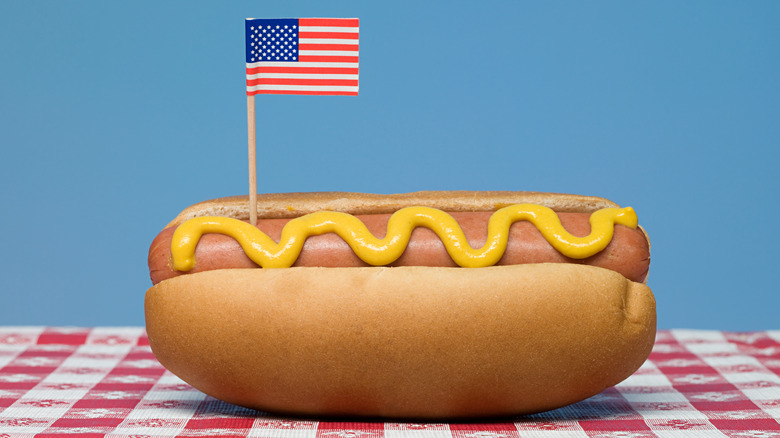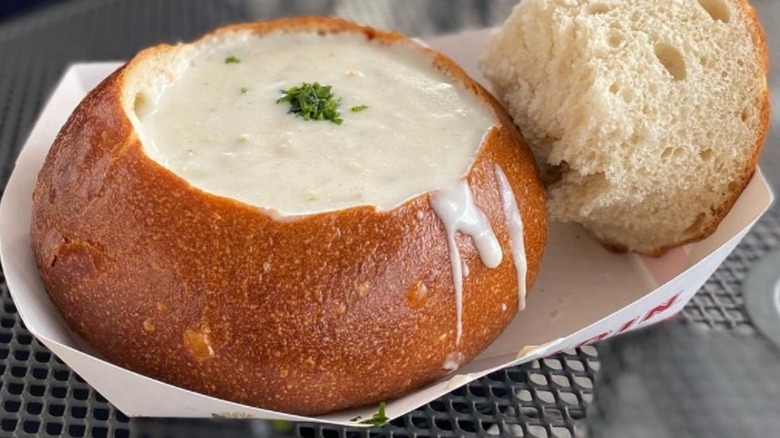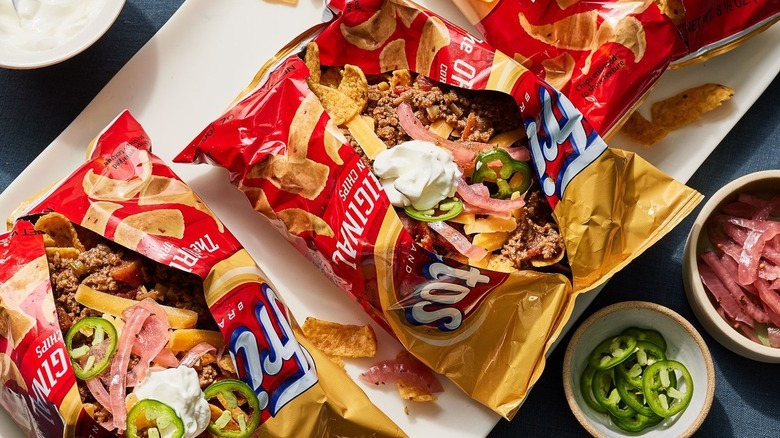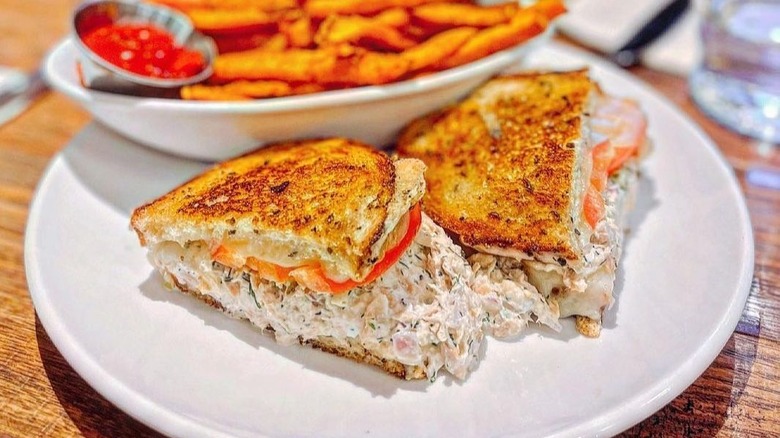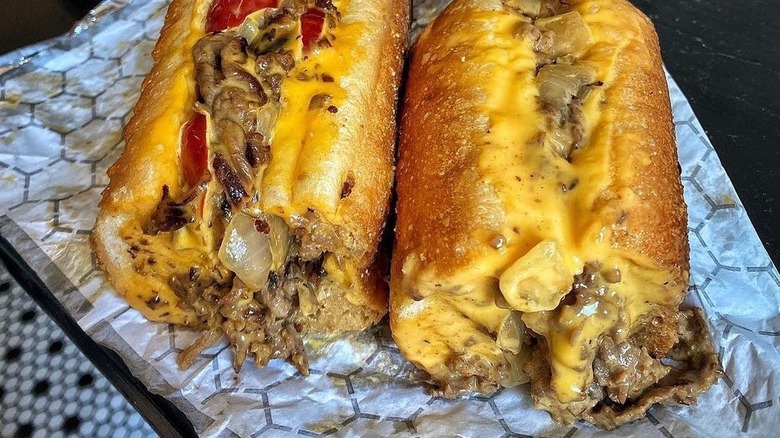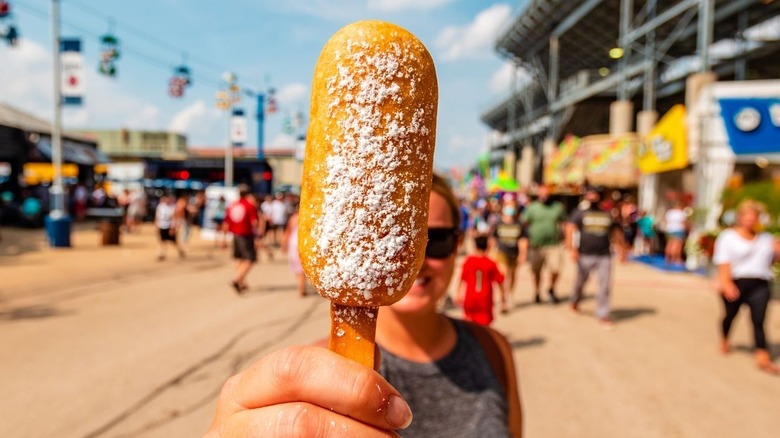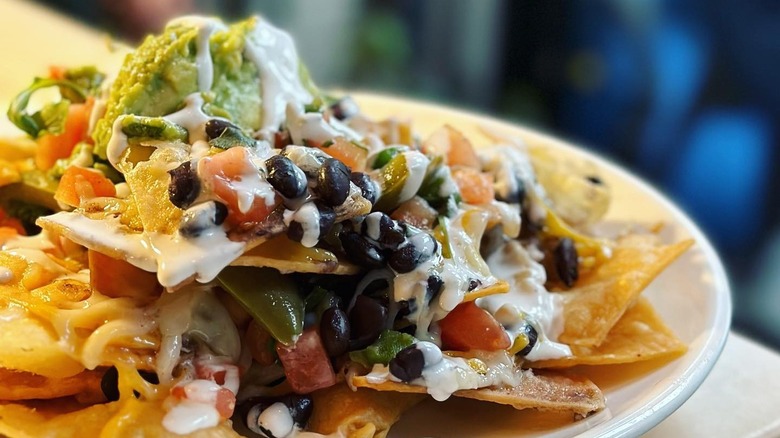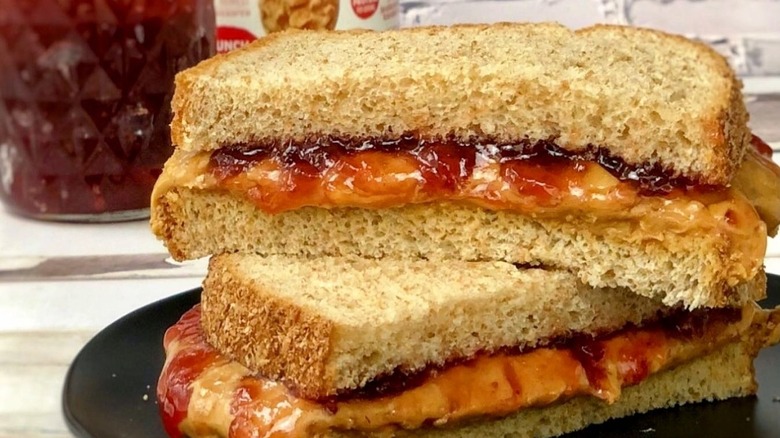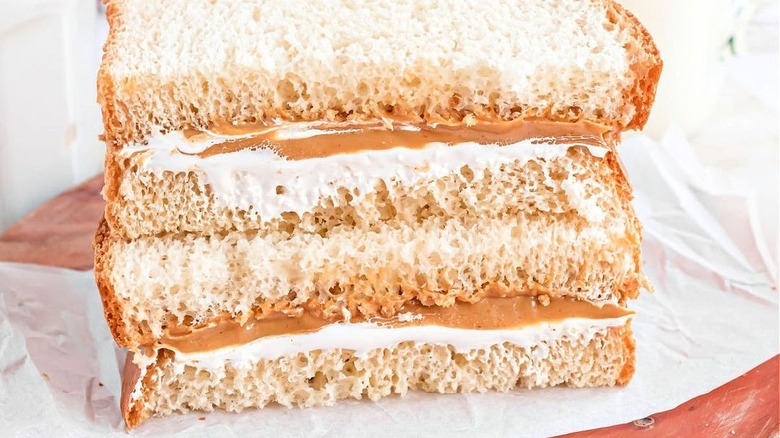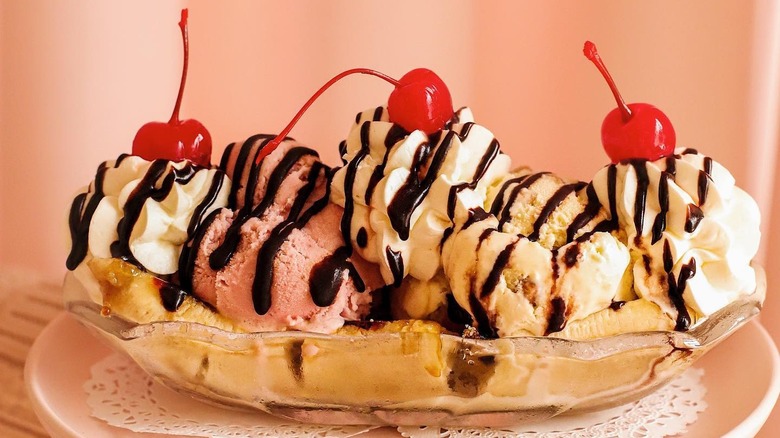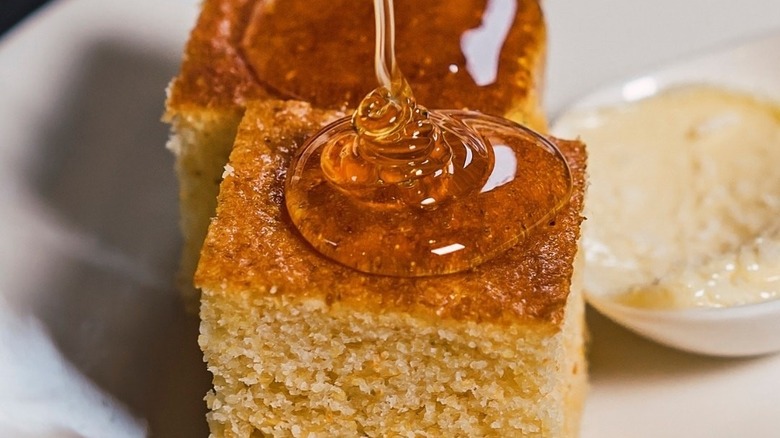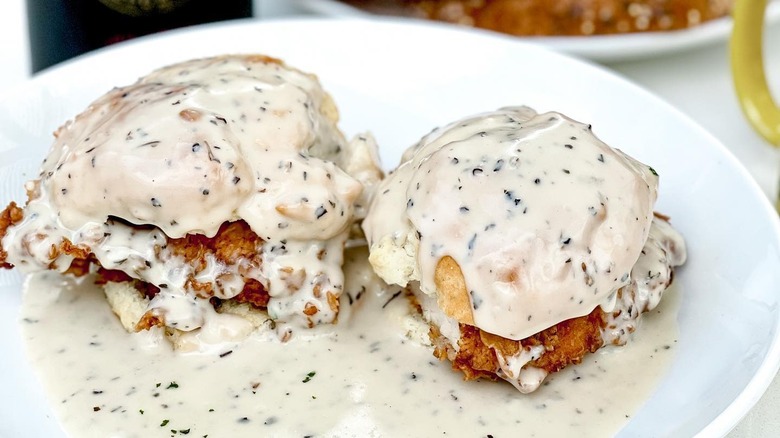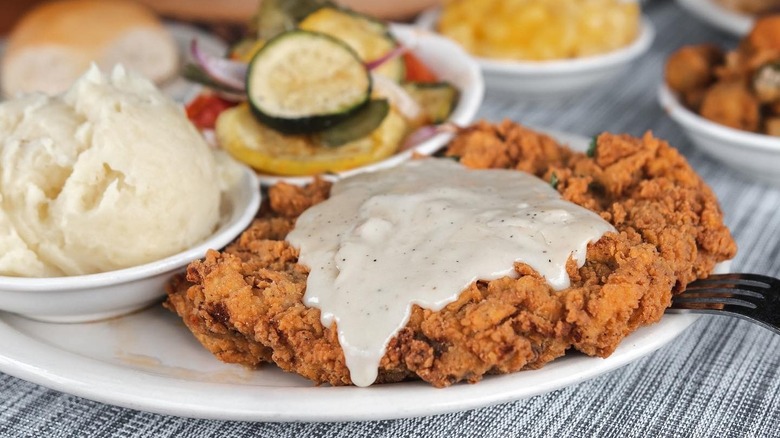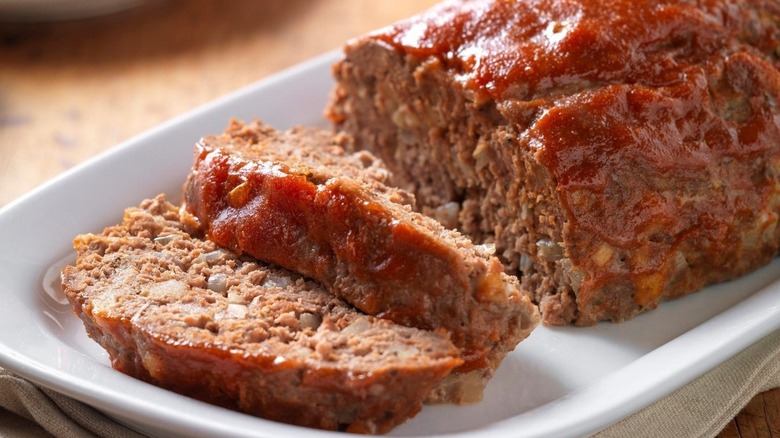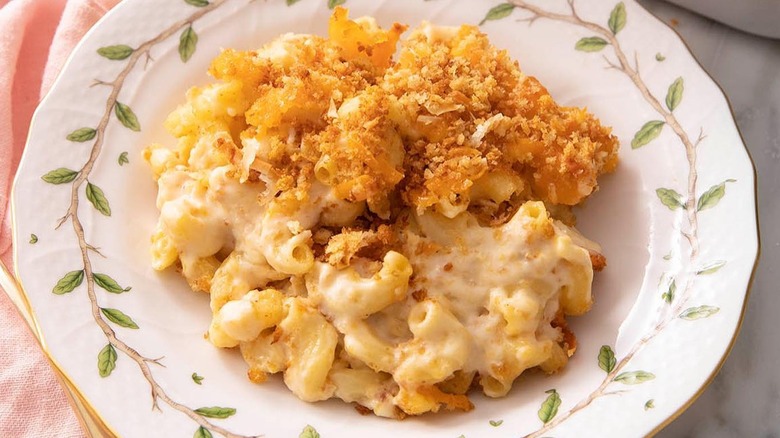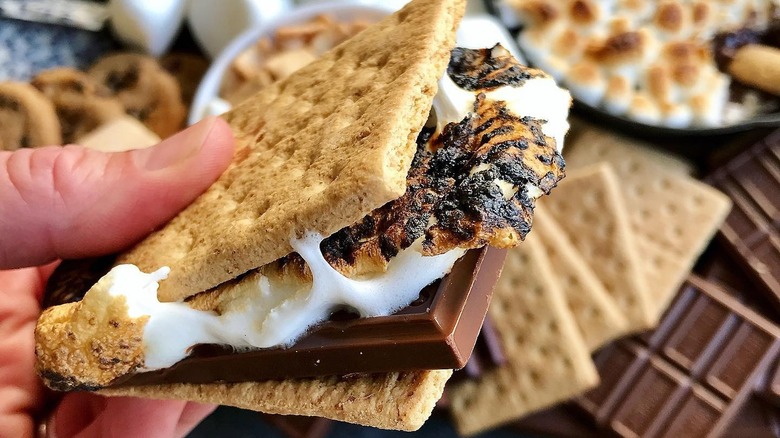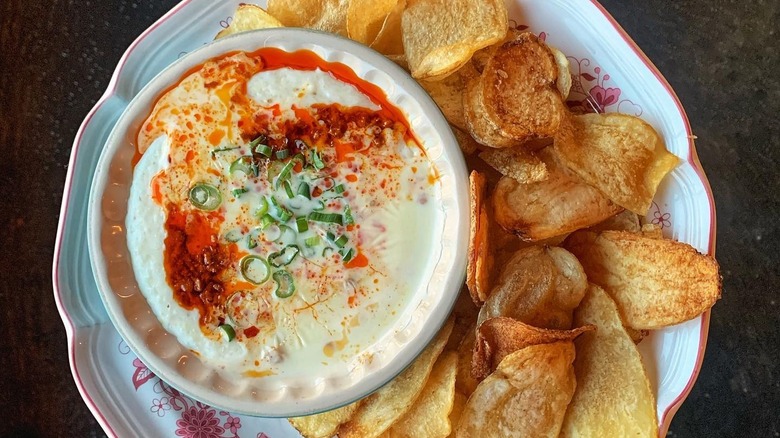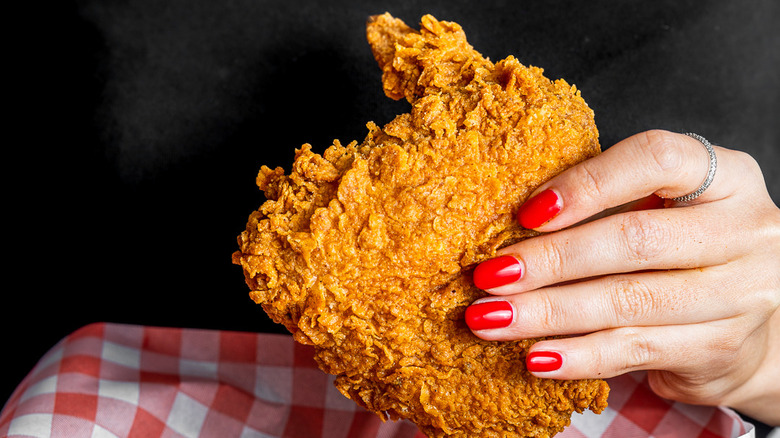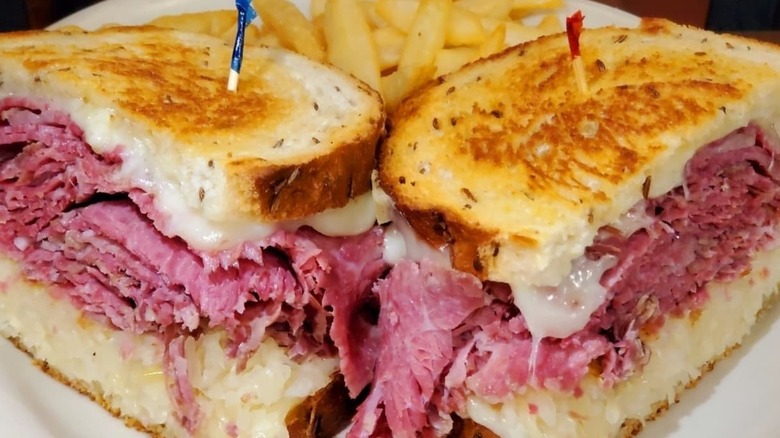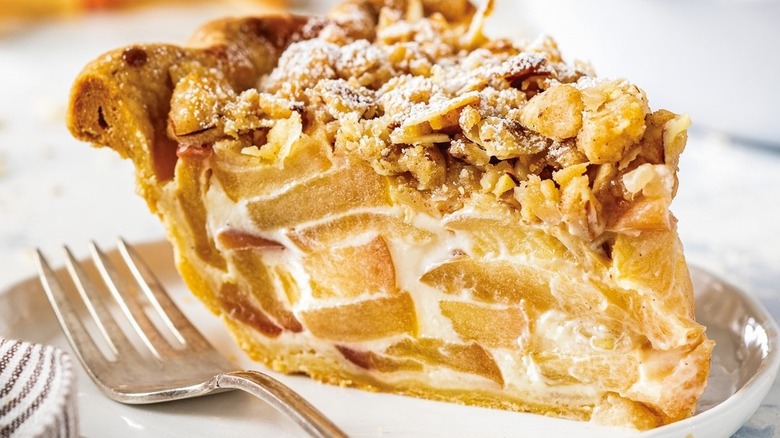20 Under-The-Radar Dishes That Define American Cuisine
Before we dig in, let's do just a little bit of math on this. For some reason, we tasked ourselves with considering nearly 335,000,000 people, with dozens of different cultural backgrounds, who enjoy a wide variety of cuisines, which also vary by state, and regional preferences within those states. What are we doing trying to define American cuisine? It could literally be anything to anyone at any time.
Still, if there's cheese on it, we're down for a challenge. We're also here to celebrate the food of this country as it is — a representation of centuries of global influence, brought to life by generations of ancestors, born of cherished traditions, challenging times, and brilliant innovation. And, all of that heritage is then shared through the simplest gesture of cooking a meal. On the flip side, we have deep-fried Twinkies. But hey, it's America. We love food and we're all about having some fun with it. From cheese grits to meatloaf, this is as American as...eh, you decide.
Hot dogs
"Hot dogs! Get your hot dogs here!" If we're talking about dishes that define America, you'd be safe in suggesting anything you can find at a baseball park. But, while we respect your box of Cracker Jack, soft pretzel, and plastic-like cheese dip, we're going for the biggest weiner of them all: the all-American hot dog.
A classic frank features beef and pork, cuddled up in a basic white bread bun, featuring one or all of these accepted toppings: ketchup, mustard, relish, onions, sauerkraut, mayo, pickle, and chili. We'll also give you that plastic cheese we mentioned earlier. Remember Oscar Mayer Cheese Dogs that were literally pumped full of cheese? Yep, still very much a thing.
If you want to taste the ubiquitous log-shaped meat of America, you can hit up Pink's in Los Angeles, or Portillo's in Chicago. But, real fans will point you to the Coney Island original, Nathan's Famous, which has been cranking out the all-beef franks since 1916. Made even more popular thanks to a beloved annual international hot dog eating contest, Bon Appétit gave the brand top marks for "intense, beefy flavor and lovely sparks of garlic." Just like a Fourth of July food sparkler in your mouth.
Sourdough bread bowls
We honor the misunderstood genius who invented a way to eat one food from the inside of a completely different food, thereby transforming the way we enjoy soup forever. The actual origins of the bread bowl remain unclear, but it's possible that a man in the Irish noble classes created a bowl made of bread and filled it with chowder, in order to make a good impression on a British royal in 1427. Apparently, even royals are easily wooed by carbs.
The sourdough trend hit the U.S. during the Gold Rush. But Boudin Bakery in San Francisco, California — a.k.a., "The king of San Francisco bread bowls," according to CBS News — popularized the hollowed-out loaf loaded with creamy goodness. They've been operating since 1849. Hit up the flagship operation at Fisherman's Wharf to taste the original.
Sourdough boasts a tangy flavor and a chewy texture, making it the perfect vessel. Inside, you'll find clam chowder, stews, chilis, and other hearty soups. The bread bowl soaks up the flavors as you enjoy your meal. And you can finish it all off by tearing up the rest of the bread and promptly leaving zero traces of your meal. Quick question though — what do they do with the insides of the bowl, and where can we get our hands on this extra sourdough? Asking for a friend.
Frito pie
Reddit understands: "Get yourself a bowl, line the bottom with Fritos, add some homemade chili (or store-bought), some shredded cheese. Stir. The heartburn in the morning is entirely worth it." But, this dish has a complicated history. Grab a bag from the snack machine and let's duke it out.
As far as Frito pie mythology goes, either Teresa Hernandez of Santa Fe, New Mexico invented Frito pie in the '60s, or Daisy Dean Doolin came up with the idea in San Antonio, Texas in the '30s. Doolin was the mother of the guy who invented Fritos, so that one's kind of fun. Still, the real story seems to be that the Frito-Lay company invented it in a test kitchen and ultimately sent the idea into the zeitgeist when the brand published the recipe on the bag in 1962. But. history, shmistory. This savory "pie" now rocks concession stands at Texas high schools, just as hard as it does the citizens of Ohio.
You can make this yourself at home (we believe in you); Just crack open a bag of Fritos, and add hot, meaty chili, shredded cheese, chopped onions, and jalapeños. But, if you want to sample that Tex-Mex flavor at a proper establishment, we've got you. Five & Dime General Store in Santa Fe, New Mexico serves up a version that had Anthony Bourdain saying, "I, in fact, very much enjoyed my Frito pie in spite of its disturbing weight in the hand. It may have felt like (expletive) but was shockingly tasty," (via the Associated Press).
Tuna melts
Charleston, South Carolina gets dibs on inventing this one, thanks to a story involving a Woolworth's department store eatery where a bowl of tuna salad allegedly fell onto a grill, atop a grilled cheese, and sparks flew (not literally). Props to whoever ate the grilled cheese with random tuna soldered onto it and discovered this match made in melty sammy heaven.
This pairing has gone global, but the American version of the tuna melt typically features a base salad composed of canned tuna and mayo, plus cheese, and bread. Get it grilled or toasted until the cheese is melted and bubbly — open-faced, or closed — and served straight up, or with a bowl of tomato soup for added bliss.
This diner and deli specialty appears just about everywhere in the U.S., but if you're looking for a classic, head to the tuna melt metropolis; S&P in New York City. The company took over the old Eisenberg's deli space in 2022, and left the tuna melt basically intact, with a mayo upgrade to the Duke's brand. Grab a seat and a basic tuna melt on rye, and bite into the comfort food of your dreams.
Philly cheesesteaks
Well, we're not gonna pretend it wasn't invented in Philly. The Philadelphia cheese steak was brought to life by South Philly's Pat Olivieri in the 1930s. This awesome hoagie-style sandwich features beefsteak, melted cheese, and toppings which we can all debate until the end of time.
But also, here's the right answer: Onions. That's it. That's the topping. Oh, and while we're here, that'll be griddled chip steak, American cheese, provolone (or gooey cheddar Whiz sauce), and sautéed onions, cooked with, or separate from, the beef. And, nothing other than an authentic Amoroso Italian roll will do, yous guys. Frank Olivieri (Pat's great nephew) explained that the cheese didn't appear in the mix until the '40s, telling Philadelphia Magazine, "The first cheese was a provolone cheese. We had a manager named Joe Lorenza, or Cocky Joe. He was always drunk, completely inebriated. A waste of our time. But he was the first person to put cheese on the sandwich."
While cheesesteaks have found their way across the country, stop by The City of Brotherly Love for this one. Taste the original — as well as several different takes on their O.G. creation — at Pat's King of Steaks in South Philadelphia, where the Olivieri family is still slicing the thinnest ribeye beef and grilling it to impossible perfection.
Deep-fried Twinkies
Welcome to the Deep-Fried States of America. From fried Coca-Cola to onion rings, and pickles to catfish, we like us a tender bite with a perfectly crispy crust, and 4,000 extra calories than the item originally had.
Deep-fried Twinkies, however, hold a special place in our little chugging hearts. Featuring a snack cake that was born in Illinois in the 1930s as "America's model junk food," the process involves coating a Twinkie in batter and then drowning it in the fryer until it gets golden and crispy on the outside, leaving the cake and filling inside to get all warm and gooey. Add a dusting of powdered sugar, and you've got a nostalgic treat from your nearest State Fair. Or go for the blue ribbon with your own setup at home.
Of course, good old American ingenuity doesn't allow the deep-fried Twinkie evolution to just end there. Since our acceptance of this food into the very fabric of our society, we've made a few improvements. Get sweet and savory with a bacon-wrapped deep-fried Twinkie, or make it a fruity combo with a fresh strawberry sauce topping. Alternatively, go luxuriously sweet and salty with a dollop of caviar, like they did at the O.C. Fair. Because, just like snowflakes, no deep-fried Twinkies are alike.
Nachos
Nachos first came to life in Mexico, in the border town of Piedras Negras in the 1940s. The dish was created by Ignacio "Nacho" Anaya, who whipped up tortilla chips topped with melted cheese and jalapeño peppers for guests when the restaurant's chef couldn't be found.
The first-ever platter featured tortilla chips, melted cheese, and sliced jalapeños. But once nachos gained some steam in America, a plate soon featured layered corn tortilla chips, melted cheddar cheese, Monterey Jack, or a blend of cheeses, and then toppings like diced tomatoes, sliced jalapeños, sour cream, guacamole, salsa, black beans, seasoned ground beef or chicken, onions, olives, and cilantro. Pretty much anything works on nachos.
Almost 90 years after Nacho made his nachos, you can find them pretty much anywhere — assembled with almost any ingredient. Get a plastic baseball helmet or a tabletop trash can piled with chips and gooey cheese for the ultimate taste of 'Merica.
PB&J
It might not be possible to conjure up more typical American kid-vibes, than with a PB&J. All you need to create the American original peanut butter and jelly sandwich is your favorite peanut butter, your favorite jelly, and two slices of the most basic white bread you can get your hands on. No, no, no, no whole wheat — get outta here with your bougie carbs.
With this sandwich, we time travel back to Home Economics, 1901. That's when author Julia Chandler suggested it as a tasty combination in The Boston Cooking School Magazine of Culinary Science and Domestic Economics. She preferred a currant or crab-apple jelly. But, she was a genius before her time.
It took a few decades, but the PB&J began to hit its stride during WWII, with soldiers adding jelly to their peanut butter sandwiches to make them stick less to the roof of their mouths. However, Joseph Rosefield had already invented a non-stick-to-mouth hydrogenated version of the peanut butter in 1922, which he called Skippy. Maybe the soldiers preferred the all-natual brand. Once they returned home, PB&Js popped up in lunch boxes and college dorms across the nation. It's still a nostalgic favorite for adults ... just cut the crust off and we're good to go.
Fluffernutters
The sweet, airy marshmallow cousin of the PB&J — the Fluffernutter — made a splash in New England, where Massachusetts first produced marshmallow fluff. In 1918, Emma E. Curtis invented the "Liberty Sandwich," which featured Snowflake brand marshmallow creme and a generous helping of peanut butter, on oat bread. Once there were marshmallows in a jar, there would soon be marshmallows and peanut butter smashed into sandwiches. If you're a marshmallow fan, this combo can't be beaten.
Again, the magic is in the simplicity of assembly. Two slices of plain Wonder Bread, creamy peanut butter, and a dollop of marshmallow fluff become one in this nostalgic treat. Fluff tastes a little different than regular marshmallows, so we shouldn't be seeing any Jet-Puffed mini marshmallows peering out from this sandwich.
Sure, it's a New England thing, but this is America. If we want to put fluff and peanut butter on a sandwich, we put fluff and peanut butter on a sandwich. As one Redditor posted, "[The] Fluffernutter sandwich is a timeless delicacy from my east coast childhood. I haven't even seen one since I was like 10 years old but omg those are good." Time to bring it back.
Banana splits
What's the easiest way to make a banana split? Slice it in half. (You're welcome.) While dads brought us that cool joke, David Evans Strickler, a soda jerk in Pennsylvania, created the banana split back in 1904. He just wanted to attract more customers to the soda fountain counter at Tassell Pharmacy. And, he low-key came up with one of the most iconic American dishes, ever. No big deal.
He cut a banana lengthwise and topped it with one scoop each of chocolate, strawberry, and vanilla ice cream, and added chocolate, pineapple, strawberry syrups, nuts, whipped cream, and a bright red cherry. (Hey, so, don't tell Wilmington, Delaware locals about this because they claim they invented the banana split in 1907 and we just want everyone to have fun.)
The old-fashioned feel just adds to the fun. Sample something close to the original at the old-school-styled Franklin Fountain in Old City, Philadelphia, where you can grab Dr. Dovey's Banana Split for a cool $20. This type of sundae cost just 10 cents back in 1904, but, hey, who's counting?
Cornbread
Cornbread's got roots, y'all. As perhaps one of the earliest foods in all of American history, this dish goes back to the indigenous tribes of North and South America, since corn grew easily in the climate. Native Americans cooked cornbread by grinding dried kernels into a coarse meal, and adding water to create a dough, which was shaped into patties and cooked over an open fire.
Later, cornbread recipes evolved to incorporate ingredients and techniques with many cultural influences. But, maybe nowhere in the U.S. is this dish as much of an iconic cuisine as it is in the South. Cornbread played a significant role in the diets of enslaved African Americans, who introduced buttermilk and shortening (among other ingredients) to create the beloved cornbread flavor we're obsessed with today. But, don't you dare say anyone makes it better than your own mama.
If mama's busy at the moment, we can get our cornbread fix at any number of soul food and Southern BBQ restaurants. While you might sink your teeth into a bread that's more cake-like, or one that's sweeter than others, we wouldn't say no to a drizzle of molasses, or a pat of butter and honey.
Biscuits 'n' gravy
While both biscuits and different types of gravy can be traced back to very early America, the combo of the two is something different altogether. It may possibly date back to the Revolutionary War, but the current consensus points to the late 1800s in Southern Appalachia. It was a cheap way to get protein during the lean times after the war. Pork drippings equaled gravy, flour equaled biscuits, and biscuits softened up with gravy equaled a hearty meal for hard laborers.
As it's recalled in The Southern Foodways Alliance Community Cookbook, "The Southern way with gravies was born of privation...And when folks are poor, folks make do. Which means folks make gravy," (via The Washington Post). These days, however, biscuits are much more soft and buttery, but the white "sawmill" gravy is very much like it was way back when. If it ain't broke, don't fix it.
Chicken fried steak
German and Austrian immigrants who settled in Texas in the 19th century breaded and fried their meats, which later gave birth to another Southern favorite: chicken fried steak. Whether those immigrants or Texan cook Jimmy Don Perkins actually invented it when he mixed up an order in 1911, this crispy fried meat quickly made friends with everyone. The name came about because, well, it looked exactly like fried chicken, and it helped distinguish this particular cooking style from other types of steaks.
While the dish may have been more recently influenced by cooks in the midwest, Texas went Instagram official with their chicken fried "blissful union" by declaring October 26th Chicken Fried Steak Day. It may not be a Lone Star State original dish, per say, but it's definitely in a serious relationship with the locals.
If you want the good-good stuff, you'll find it at Bubba's Cooks Country in Dallas, Texas. As one Yelper noted, "Order chicken fried steak, cherry cobbler, sweet tea and a nap. This is the perfect food coma inducing formula." Done. Zzzzzzzz.
Meatloaf
Not just the name of the late singer of the 1993 hit, "I Would Do Anything For Love," meatloaf is also an undeniably quintessential American dish. So, have we then gained the rights to the meaty "loaf" shape? We can't really say, but we sure do know how to put ketchup on it.
Immigrants from Germany and Scandinavia brought their recipes and culinary techniques to the United States, where those traditions adapted and evolved over time. According to food historian Andrew Smith, back in the 1870s, the first ever meatloaf recipe called for chopping up and throwing in "whatever cold meat you have," (via Bon Appétit). This way home cooks could bulk up what little protein people typically had at home. And now, it's a delicious way to take a comforting trip back in time to easier days.
Of course, the classic American meatloaf has its standards: ground beef, breadcrumbs, onions, an egg, and seasonings. And, while it's fairly simple to put together yourself, we all know what this Redditor is talking about; "Bad meatloaf is a doorstop. Good meatloaf is heaven."
Macaroni and cheese
Sure, Italians have been doing pasta and cheese for centuries. Molto delizioso. Buuuuuut, we're talking about America where we've collectively created a molten cheese monster of a sensation.
Several different people have been named as inventors of macaroni and cheese; former U.S. president Thomas Jefferson and his enslaved cook James Hemings, the Roman Empire's Marcus Porcius Cato back in 160 BCE, and chef Maestro Martino in 1465. Right now our brains feel like macaroni and cheese. But, it looks like the first ever recipe to feature a thick sauce of butter and flour (most like we do it now) appeared in The Experienced English Housekeeper cookbook by Elizabeth Raffald in 1769. All hail Liz.
As is the case with most American favorites, a standard recipe opens the door to endless variations. Step up the flavor with lobster mac, a bacon and caramelized onion pairing, or serve it with waffles and hot sauce for the win.
S'mores
Of course this one's a part of the Girl Scout cookie dynasty. While the graham cracker and Hershey's brand chocolate bar dominated on their own, only an earnest former snack badge champion (we assume) troop leader, Loretta Scott Crew, could have invented something to actually satisfy a bunch of wild kids on a camping trip.
The first known recipe for a treat resembling S'mores appeared in a 1927 pamphlet called Tramping and Trailing with the Girl Scouts. Tired and hungry from all the tramping and trailing, the girls enjoyed "Some Mores" by placing a marshmallow and a piece of chocolate between two graham crackers, then warming it over a campfire until it was gooey and toasty. While we might have our own opinions on whether to toast the whole thing at once, or start with just the marshmallow, the classic S'more stacks up like this: ½ Honey Maid graham, 2 rectangles of a Hershey's chocolate bar, 1 Jet-Puffed marshmallow, ½ Honey Maid graham. Eat. Repeat.
S'mores frequently pop up on restaurant menus, tugging on your sentimental heartstrings. But the best S'more is the one you toast yourself. Mix up the cookies, swap out the chocolate, but never forget the mallow you bravely roasted by hand, which lit up like a flaming meteor, fell into the ash and embers of the fire, and was then smashed into a sandwich. If that doesn't taste like victory, nothing does.
Grits
We got 99 problems, but corn ain't one. Another hero of Southern American cuisine would no doubt have to be grits. This staple favorite began as European settlers borrowed from the culinary traditions of the native Muskogee and Choctaw tribes, who had already mastered a crop that was hearty and flourishing. The dish became so popular that enslaved populations as well as property owners all ate grits. Today, all sorts of varieties of the food appear in Michelin-starred restaurants, greasy spoon diners, and everywhere in between. They remain an iconic symbol of heritage, innovation, and hospitality; a perfect dish for America.
When they're done right, they're ridiculously delicious as a side, or a base for shrimp or sausage and gravy. Featuring four different styles — hominy, stone-ground, instant, and quick-cooking — we're partial to stone-ground and slow-cooked, with salt, butter, and cheese. Just trying to put cheese on everything, per usual.
This dish runs the gamut from sweet to savory, depending on what toppings and seasonings you like. Make breakfast grits with an egg and bacon, or pancake-style grits with maple syrup, butter, and fresh berries. One Redditor offers the answer key to the whole tasteless grits situation, with this: "Salt, butter, and brown sugar. Salt, butter, and maple syrup. Salt, butter, cheese, and bacon. Salt, butter, chili, and lime." Salt, butter, and bon appétit.
Fried chicken
Before you come for us with your fried chicken manifesto, let's take a minute to thank our ancestors for gifting us this holy grail of fried meats. Ancient Romans deep-fried their chickens. African cooking techniques and seasonings greatly influenced the flavors and preparation. And, Southern traditions launched the explosion of fried chicken as an archetype of American cuisine.
KFC also commercialized the dish — and those still-secret 11 herbs and spices — making it widely accessible across the country, starting in the 1930s. Fried chicken as a whole quickly fused with Southern culture, often popping up at social gatherings, picnics, and family reunions. It's affordable, simple, tender, and succulent, with a crispy crust that's perfectly seasoned and reminds you of the good old days.
Of course, we all have different ideas on the person who does it up best. Still, taking everyone's grandma out of the equation (love you, grandmas!), we have a few favorite styles: buttermilk country fried, Korean fried, Karaage or Japanese fried, Nashville hot ... just let us know if we should stop...smoked and fried, tandoori fried, Southern fried, ramen fried, beer fried ...
Reuben sandwiches
How could this thing have such an insane backstory? It's just a pastrami sandwich. We might be stepping straight into the Thousand Island, but here goes. As far as the invention of the seminal Reuben sandwich, one theory suggests that a grocer in Omaha, Nebraska named Reuben Kulakofsky created it in the 1920s, during a late-night munchies sesh with his poker friends. But, then there's Arnold Reuben, a German-Jewish immigrant and owner of Reuben's Delicatessen in New York City, who reportedly named a pastrami sammy after himself around the same time.
But wait. A third contender emerges: Bernard Schimmel. He was a cook and fellow poker player who actually made the sandwich (draining the kraut and adding Thousand Island dressing to it) that Reuben Kulakofsky had requested (as just pastrami and sauerkraut). Allegedly.
You know what would solve this? A nice, hefty Reuben sandwich. Get it with corned beef, Swiss cheese, sauerkraut, and Russian dressing, on rye bread, or go for a pastrami, with Swiss cheese, coleslaw, and Russian dressing, on rye. Here's to you, Reuben, Arnold, Bernie, and anyone else that wants to get in on this.
Apple pie
Whether you eat it fresh out of the oven, piled high with whipped cream, with a slice of cheddar, a scoop of vanilla, or drenched in cold milk, apple pie is as American as ... yep, apple pie.
European settlers first introduced apples to America. And then we immediately baked them into pies. At least, that's what we would have been doing. Soon, apple pie wove its way into American culture, consistently on trend as a traditional dessert for Thanksgiving and the Fourth of July, since forever. But, considering the wingspan of these United States, no less than one billion takes on this beloved classic have been eaten. Give or take a few.
Early branding of the apple pie sold us a fresh-baked representation of the American way of life. But it now takes on a new interpretation through our modern eyes. American Pie Council member John Lehndorff explained, "When you say that something is 'as American as apple pie,' what you're really saying is that the item came to this country from elsewhere and was transformed into a distinctly American experience," (via Food52). Hmm. Kind of sounds like all of us, right?

